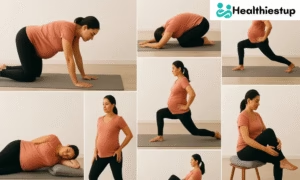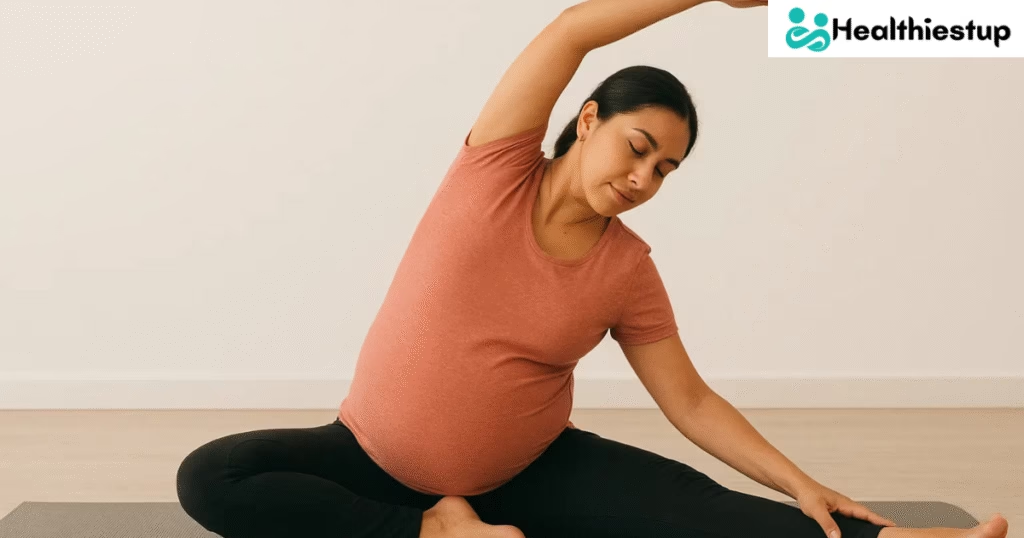Introduction
Lower Back Stretches: Pregnancy is one of the most beautiful journeys a woman can experience, but it also comes with its share of physical challenges. One of the most common discomforts expecting mothers face is lower back pain. As the body changes to accommodate the growing baby, the spine and pelvis undergo extra stress, leading to stiffness, soreness, and even difficulty moving freely. Thankfully, gentle and safe lower back stretches can help ease these discomforts, promote relaxation, and support overall mobility throughout pregnancy.
In this guide, we’ll explore safe, doctor-recommended stretches that can bring much-needed relief to expecting mothers. We’ll also discuss the benefits, precautions, and practical tips to ensure you stretch safely during each trimester.
Why Lower Back Pain is Common During Pregnancy
Lower back pain in pregnancy usually results from a combination of hormonal, structural, and lifestyle changes. The body releases a hormone called relaxin, which loosens the ligaments and joints to prepare for childbirth. While this is necessary, it also makes the joints more vulnerable to strain. Additionally, as the belly grows, the center of gravity shifts forward, causing more pressure on the spine.
Other contributing factors include:
- Weight gain adding extra load on the lower back.
- Poor posture due to belly growth and breast enlargement.
- Weakened abdominal muscles that can no longer support the spine effectively.
- Long hours of standing or sitting without adequate movement.
Benefits of Stretching During Pregnancy
Stretching isn’t just about flexibility it’s also about comfort, circulation, and preparation for childbirth. Here’s why lower back stretches are especially beneficial during pregnancy:
- Reduces stiffness and tension in the lower back and hips.
- Improves posture, helping you stand and sit more comfortably.
- Promotes blood circulation, reducing swelling in the legs and feet.
- Relieves pressure on the spine and pelvis.
- Enhances relaxation, lowering stress and improving sleep quality.
- Prepares the body for labor by maintaining mobility in the hips and pelvis.
Safe Lower Back Stretches for Pregnancy Relief
Lower Back Stretches: Before starting, remember: always consult your healthcare provider before beginning any new exercise routine during pregnancy. Perform these stretches gently, without pushing your body too far. Breathe deeply and move slowly, stopping immediately if you feel sharp pain.
1. Cat-Cow Stretch (Pelvic Tilt)
Lower Back Stretches: This yoga-inspired stretch helps relieve tension in the spine, promotes flexibility, and improves posture.
How to do it:
- Get on your hands and knees with your wrists under your shoulders and knees under your hips.
- Inhale as you drop your belly toward the floor, lifting your head and tailbone upward (Cow Pose).
- Exhale as you tuck your chin and round your back toward the ceiling (Cat Pose).
- Repeat slowly 8–10 times.
2. Child’s Pose (Modified)
Lower Back Stretches: This gentle pose relaxes the lower back, hips, and shoulders, while calming the mind.
How to do it:
- Kneel on the floor, spreading your knees apart to make room for your belly.
- Sit back on your heels and stretch your arms forward.
- Rest your forehead on the floor or a cushion for comfort.
- Hold for 30–60 seconds while breathing deeply.
3. Seated Forward Bend (Wide-Leg)
Lower Back Stretches: A safe variation of a forward bend that stretches the spine and opens the hips.
How to do it:
- Sit on the floor with legs spread wide apart.
- Place a cushion under your hips for support.
- Slowly lean forward, placing your hands on the floor in front of you.
- Keep your spine straight and stop before feeling any strain.
- Hold for 20–30 seconds.
4. Standing Hip Flexor Stretch
Lower Back Stretches: This stretch eases tension in the hips and lower back caused by carrying extra pregnancy weight.
How to do it:
- Stand with your right foot forward and left foot back.
- Bend your right knee while keeping the left leg straight.
- Place your hands on your hips for support.
- Gently press your hips forward to stretch the hip flexors.
- Hold for 20–30 seconds, then switch sides.
5. Figure-Four Stretch (Seated or Lying Down)
Lower Back Stretches: This stretch targets the glutes and lower back, helping reduce sciatica-like pain.
How to do it (seated version):
- Sit on a chair with your back straight.
- Cross your right ankle over your left knee, forming a “4” shape.
- Lean slightly forward to deepen the stretch.
- Hold for 20–30 seconds, then switch legs.
6. Pelvic Tilts (Wall Support Version)
Lower Back Stretches: Pelvic tilts are a classic exercise for strengthening the lower back and abdominal muscles while reducing tension.
How to do it:
- Stand with your back against a wall, feet about a foot away from the wall.
- Gently tilt your pelvis forward so your lower back presses against the wall.
- Hold for 5 seconds, then release.
- Repeat 8–10 times.
This stretch strengthens core stability and relieves pressure on the spine.
7. Butterfly Stretch
Lower Back Stretches: The butterfly stretch opens up the hips and groin while easing tension in the lower back.

How to do it:
- Sit on the floor with your feet together and knees bent outward.
- Hold your feet with your hands and keep your spine straight.
- Gently press your knees toward the floor (do not force them).
- Hold for 20–30 seconds while breathing deeply.
This stretch not only reduces back stiffness but also prepares the pelvis for childbirth.
8. Side-Lying Stretch
Lower Back Stretches: A safe, relaxing position especially useful in the second and third trimesters.
How to do it:
- Lie on your left side with a pillow between your knees for support.
- Extend your top arm overhead and gently stretch your body sideways.
- Breathe deeply and hold for 20–30 seconds.
- Switch sides for balance.
This helps reduce lower back strain and improves circulation to the baby.
9. Supported Squat Stretch
Lower Back Stretches: Squats, when done with support, gently stretch the lower back, hips, and thighs.
How to do it:
- Stand with your feet shoulder-width apart.
- Hold onto a sturdy chair or wall for balance.
- Slowly lower yourself into a squat position, keeping your heels on the floor.
- Hold the position for 20–30 seconds, then rise back up.
This stretch not only relieves back tension but also strengthens the pelvic floor muscles.

Safety Tips for Stretching During Pregnancy
Lower Back Stretches: While stretching can be incredibly helpful, it’s important to stay mindful of your body’s limits. Keep these tips in mind:
- Avoid lying flat on your back after the first trimester.
- Use props like pillows, yoga blocks, or chairs for extra support.
- Never push yourself into a painful stretch.
- Stay hydrated and breathe deeply throughout each movement.
- If you feel dizziness, cramping, or vaginal bleeding, stop immediately and contact your doctor.
Conclusion
Lower Back Stretches: Lower back pain doesn’t have to be an unavoidable part of pregnancy. With the right stretches, you can ease discomfort, support your growing body, and prepare for a smoother labor. These safe, doctor-approved movements not only bring physical relief but also encourage relaxation and mental well-being. By practicing them regularly, you’ll give your back the care it deserves while nurturing your little one inside.
FAQs
Q1. Can I stretch every day during pregnancy?
Yes, gentle stretching daily is safe for most women, but always listen to your body and consult your doctor.
Q2. When should I avoid stretching during pregnancy?
Avoid stretching if you experience bleeding, severe pain, dizziness, or if your doctor has advised limited movement.
Q3. Are yoga and prenatal Pilates safe during pregnancy?
Yes, prenatal yoga and Pilates are generally safe and effective when guided by a trained instructor.
Q4. Can stretching help with labor preparation?
Absolutely! Stretching improves flexibility in the hips and pelvis, which can support easier labor.
Q5. What’s the best time of day to stretch during pregnancy?
Anytime works, but many women find relief stretching in the morning to ease stiffness or at night to relax before sleep.



